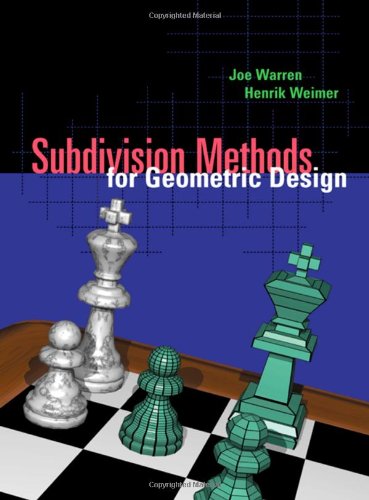Items related to Subdivision Methods for Geometric Design: A Constructive...
Subdivision Methods for Geometric Design: A Constructive Approach (The Morgan Kaufmann Series in Computer Graphics) - Hardcover

Synopsis
Subdivision Methods for Geometric Design provides computer graphics students and designers with a comprehensive guide to subdivision methods, including the background information required to grasp underlying concepts, techniques for manipulating subdivision algorithms to achieve specific effects, and a wide array of digital resources on a dynamic companion Web site. Subdivision Methods promises to be a groundbreaking book, important for both advanced students and working professionals in the field of computer graphics.
The only book devoted exclusively to subdivision techniques
Covers practical topics including uniform Bezier and B-Spline curves, polyhedral meshes, Catmull-Clark subdivision for quad meshes and objects with sharp creases and pointed vertices
A companion website provides example code and concept implementations of subdivision concepts in an interactive Mathematica environment
"synopsis" may belong to another edition of this title.
Review
Although computer graphics applications have grown remarkably easy to use, there is absolutely nothing simple about how they work. One of the most difficult aspects is the creation of smooth or organic shapes using the inherently flat polygon approach to modeling. Subdivision Methods for Geometric Design describes the contemporary approach to solving this problem.
It is not an unheard-of practice--large computer animation studios such as Pixar not only use this approach, but some of their researchers helped pioneer it. Learning how subdivisions work, though, and applying them in your application is the tricky part. In this valuable textbook, the authors attempt to explain the approach and usage of this valuable technique.
Spanning eight chapters and 275 pages of text, this hardcover is divided loosely into three parts. The first part is an introduction to subdivision and techniques for creating subdivision schemes. The second part, chapters 4 through 6, focuses on "a new differential method for constructing subdivision schemes." Later sections explore the techniques and practice of applying subdivision to polyhedral meshes, most commonly found in computer modeling systems where smooth forms are desirable.
This is certainly not a book for the common computer programmer. It is specific and detailed, targeted at the narrow band of programmers writing graphics applications whose desired output is smooth and organic shapes. Subdivision Methods for Geometric Design offers valuable insight and explanation, but it is not for the lighthearted enthusiast. --Mike Caputo
From the Back Cover
"The authors of this book have been on the forefront of these advances, and this book represents the first comprehensive description of subdivision methods. However, the book is not simply a collection of material that can be found in the open literature. Rather, it offers a deep and unique perspective into the world of subdivision. I learned a tremendous amount from reading this book. I'm sure you will, too."
—Tony DeRose, Pixar Animation Studios
The world's leading animation houses rely increasingly on subdivision methods for creating realistic-looking complex shapes. However, until now there was no one book devoted to this powerful geometric modeling technique. Subdivision Methods for Geometric Design does the job with authority and precision, providing all that is needed to understand how subdivision works its magic, and how to make that magic work.
Throughout the book, icons cue readers to visit a companion website loaded with interactive exercises, implementations of the book's images, and supplementary material. Rich in theory, analysis, and practical information, this book is the complete resource for subdivision methods.
Features:
*The result of a collaboration between a leading university researcher and an industry practitioner
*The only book devoted exclusively and comprehensively to this important new technology
*Provides solid background and theoretical analysis of subdivision as well as a wide variety of specific applications
*Addresses algorithms for Bezier and uniform B-Spline curves, Catmull-Clark subdivision for quad meshes, and regularity tests for polyhedral meshes
*The companion website (www.subdivision.org) provides opportunities for readers to experiment hands-on with implementations in a richly interactive environment
*Includes a foreword by Tony DeRose, recipient of the 1999 ACM Computer Graphics Achievement Award for his seminal work in subdivision methods
"About this title" may belong to another edition of this title.
- PublisherMorgan Kaufmann
- Publication date2001
- ISBN 10 1558604464
- ISBN 13 9781558604469
- BindingHardcover
- LanguageEnglish
- Edition number1
- Number of pages320
Shipping:
US$ 4.99
Within U.S.A.
Search results for Subdivision Methods for Geometric Design: A Constructive...
Subdivision Methods for Geometric Design: A Constructive Approach
Seller: Chamblin Bookmine, Jacksonville, FL, U.S.A.
4to Hardcover. Condition: Very Good. 1st. 299p. White pages are unmarked. Blue boards are glossy and clean with gently bumped upper corners. Tightly bound with secure hinges. Supplements not included. Name written on bottom edge of text-block. Seller Inventory # 96140
Quantity: 1 available
Subdivision Methods for Geometric Design: A Constructive Approach (The Morgan Kaufmann Series in Computer Graphics)
Seller: DFTP Holdings, DAYTON, OH, U.S.A.
Hardcover. Condition: Good. Used Texts May Have Used Book Stickers on the Cover. Used texts may NOT contain supplemental materials such as CD's, info-trac, access codes, etc. Satisfaction Guaranteed! Seller Inventory # 2005220
Quantity: 1 available
Subdivision Methods for Geometric Design: A Constructive Approach (The Morgan Kaufmann Series in Computer Graphics)
Seller: dsmbooks, Liverpool, United Kingdom
Hardcover. Condition: Good. Good. book. Seller Inventory # D8S0-3-M-1558604464-2
Quantity: 1 available
